Unit 3 Getting togetherTopic 3 第4课时 课件(仁爱科普版七年级上册)
文档属性
| 名称 | Unit 3 Getting togetherTopic 3 第4课时 课件(仁爱科普版七年级上册) | 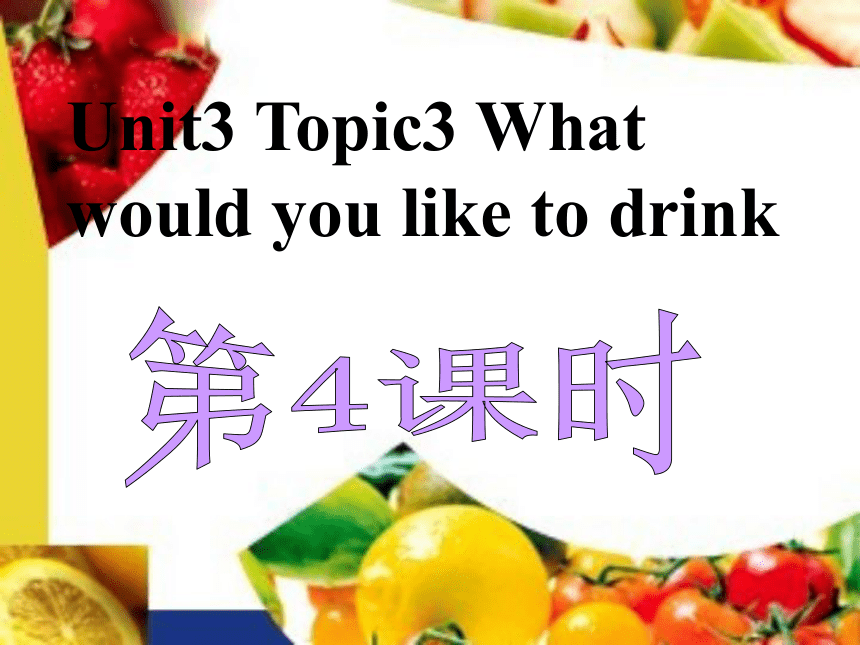 | |
| 格式 | ppt | ||
| 文件大小 | 3.4MB | ||
| 资源类型 | 试卷 | ||
| 版本资源 | 仁爱科普版 | ||
| 科目 | 英语 | ||
| 更新时间 | 2023-07-24 10:49:40 | ||
图片预览


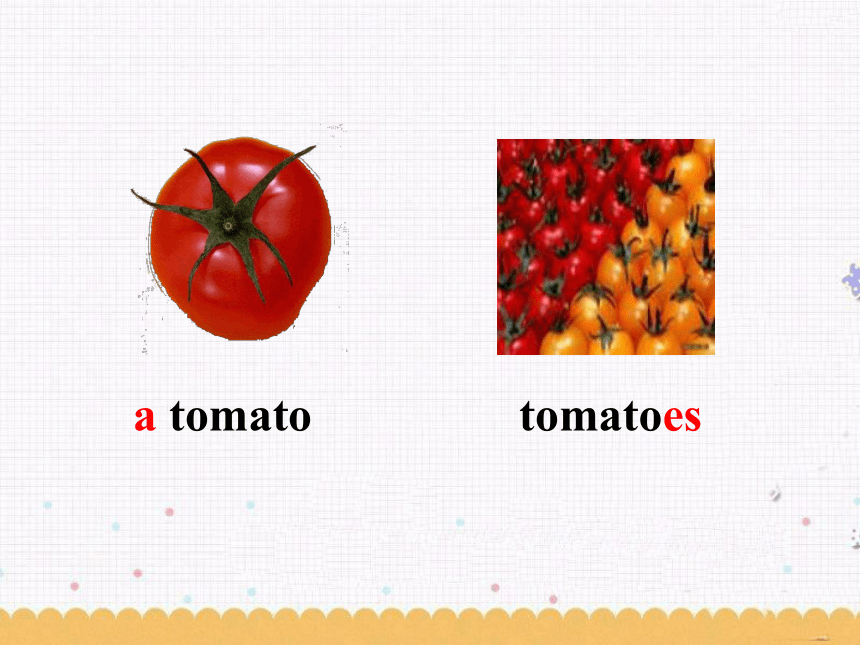

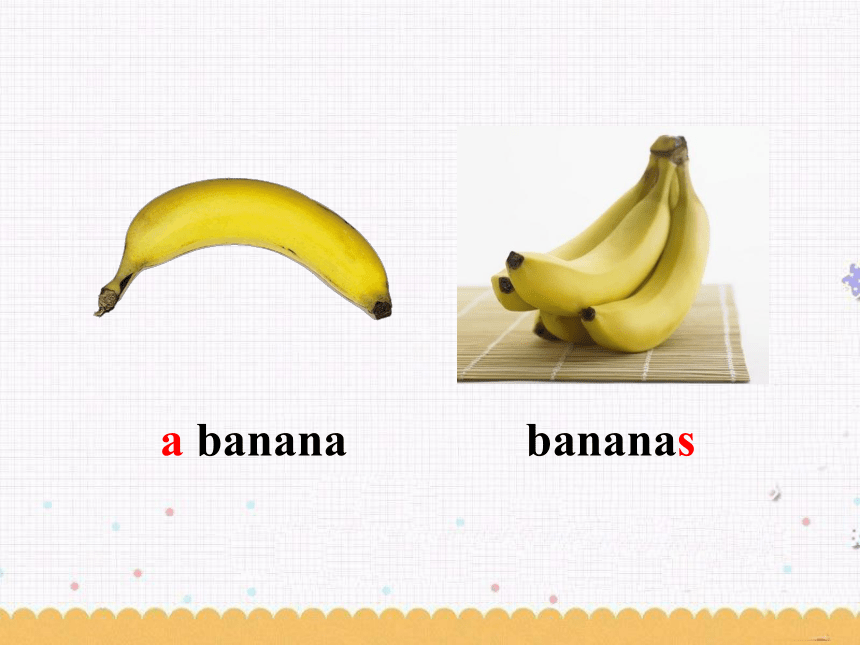
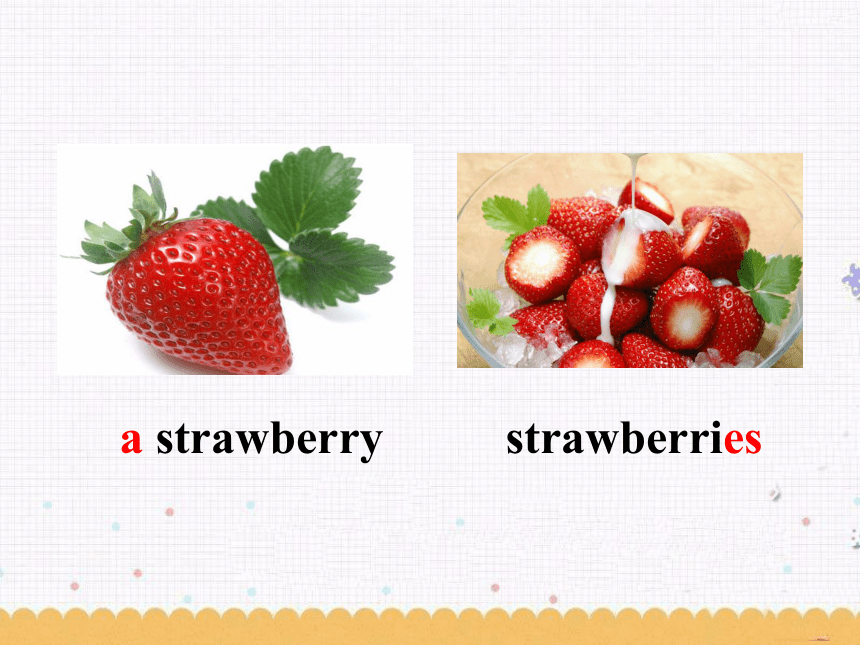
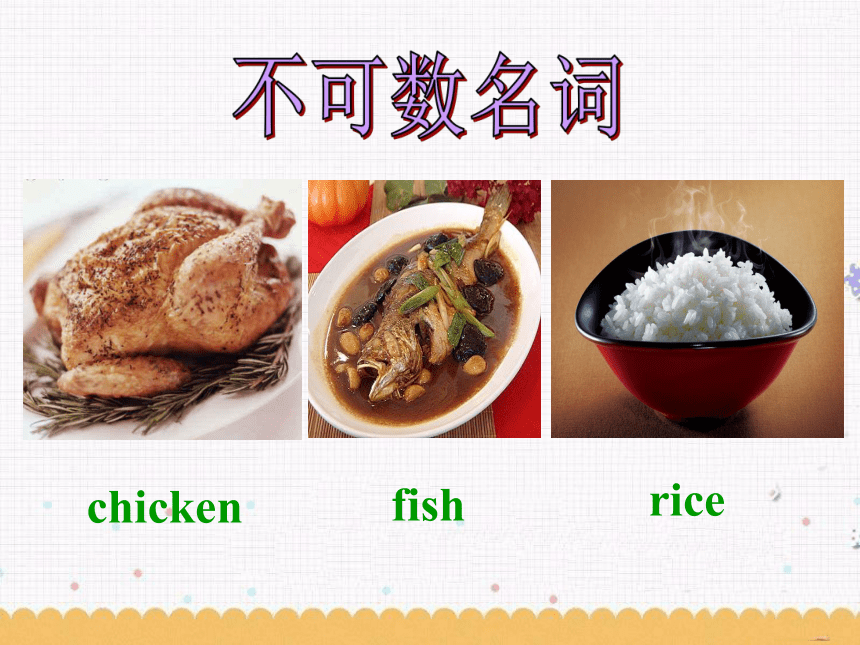
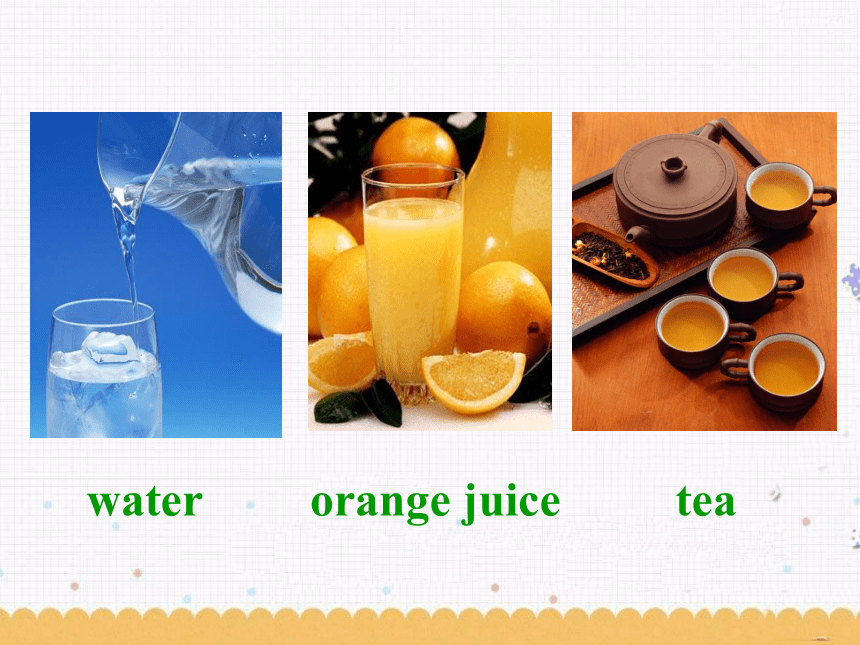
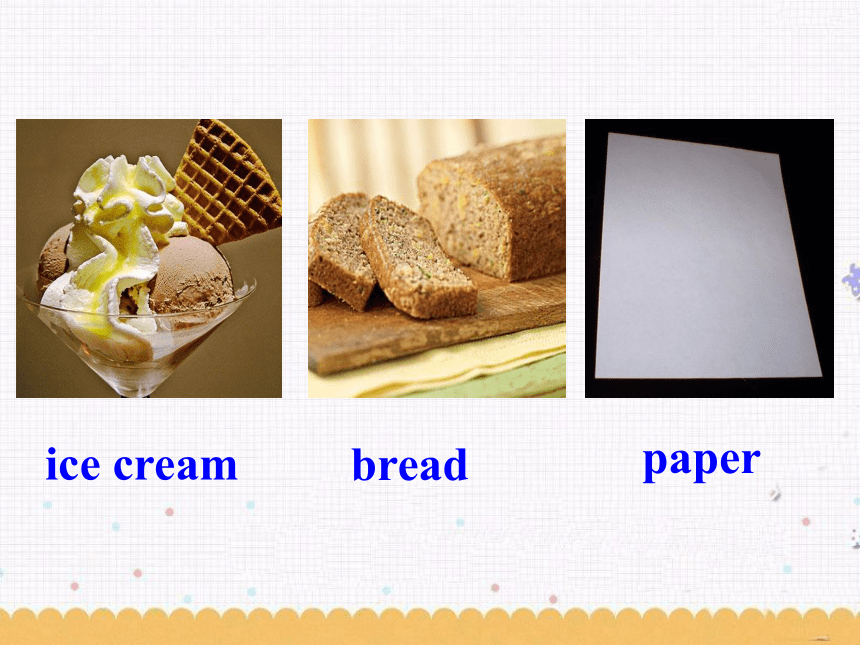
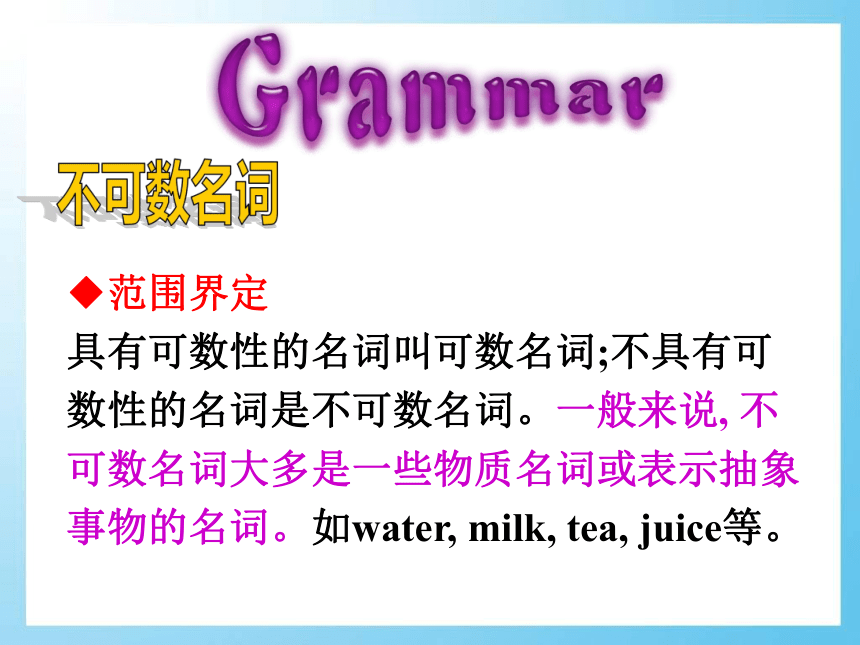
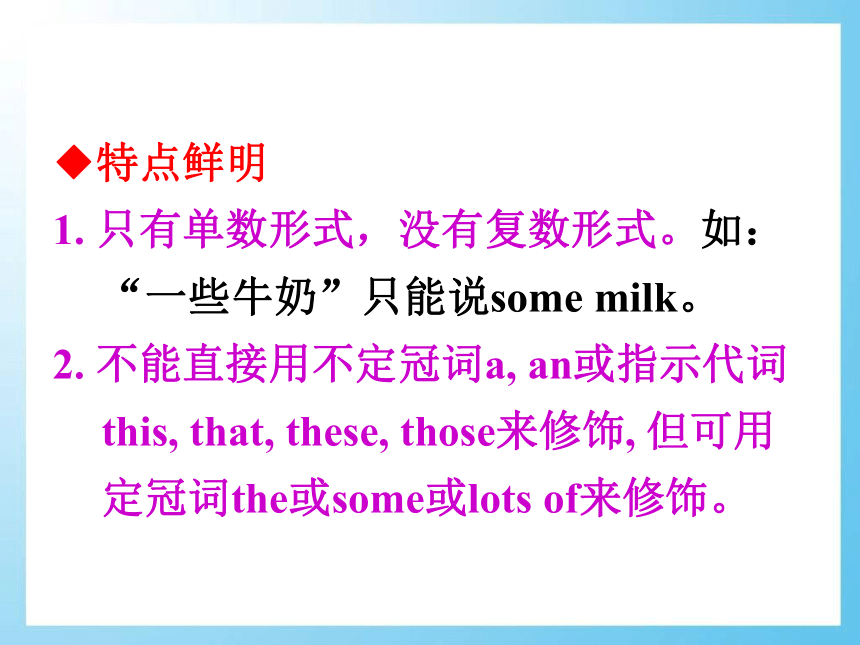
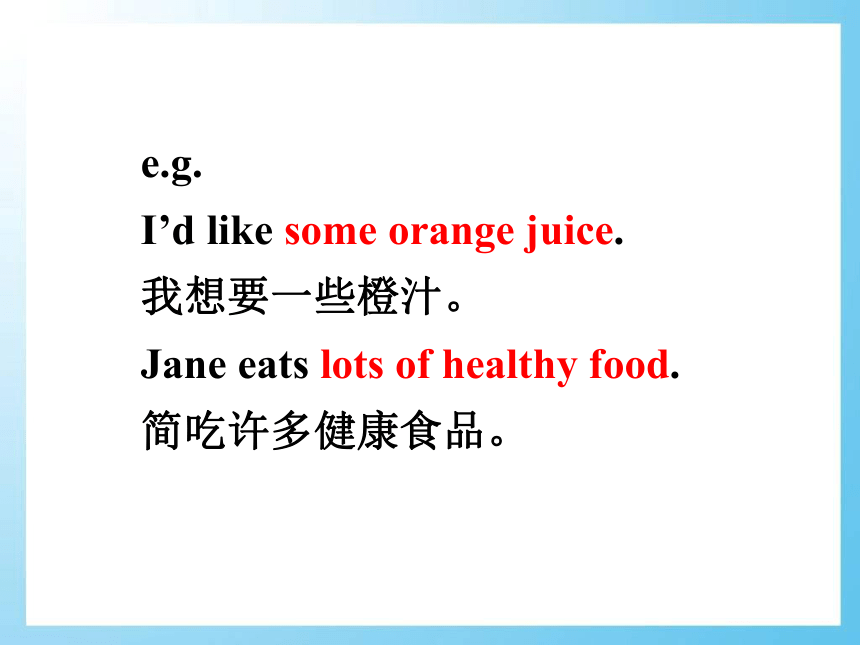
文档简介
(共32张PPT)
Unit3 Topic3 What would you like to drink
a hamburger
hamburgers
tomatoes
a tomato
oranges
an orange
bananas
a banana
a strawberry
strawberries
chicken
rice
fish
water
orange juice
tea
ice cream
bread
paper
◆范围界定
具有可数性的名词叫可数名词;不具有可数性的名词是不可数名词。一般来说, 不可数名词大多是一些物质名词或表示抽象事物的名词。如water, milk, tea, juice等。
◆特点鲜明
1. 只有单数形式,没有复数形式。如:“一些牛奶”只能说some milk。
2. 不能直接用不定冠词a, an或指示代词this, that, these, those来修饰, 但可用定冠词the或some或lots of来修饰。
e.g.
I’d like some orange juice.
我想要一些橙汁。
Jane eats lots of healthy food.
简吃许多健康食品。
3. 作主语时, 谓语动词要用单数形式。
e.g. There is a little water in the glass.
玻璃杯里有一点水。
4. 用代词指代不可数名词时, 用单数it, 不能用复数they或 them。
e.g. I like tea. Do you like it
我喜欢茶。你喜欢吗?
◆数量表达
要表示不可数名词的数量,通常需借助
结构“a + 可数名词 + of”。
e.g. a piece of meat 一块肉
a glass of milk 一杯牛奶
如果数目不止一个,要将of前面的可数
名词变为复数。
e.g. two cups of tea 两杯茶
four glasses of juice 四杯果汁
【温馨提示】
有些词既可作可数名词, 也可作不可数名词, 但表达的意思有所不同。
e.g. These are oranges.
这些是橙子。(可数名词)
We want to have some orange.
我们想喝些橙汁。(不可数名词)
【梳理】 请将下列两组句子的序号按类别写到相应的横线上。
1. ① Would you like to have lunch with me
② Thank you. I would like an egg and some rice.
③ What would you like to drink / eat
④ No, thanks. I’d like some milk.
⑤ Would you like some eggs
⑥ Good idea.
⑦ Help yourself / yourselves to some fish.
⑧ What about some orange juice
⑨ Yes, I’d like to.
⑩ Why not have some chicken
a. 主人邀请或招待客人的常用语有:
b. 客人对主人的邀请或招待的应答
语有:
①③⑤⑦⑧⑩
②④⑥⑨
2. ① May I help you
② Let me see.
③ Would you like something to drink / eat
④ Yes, please.
⑤ Waite a moment, please.
⑥ Orange juice, please.
⑦ No, thanks.
a. 在餐馆就餐时, 服务员的常用语有:
b. 在餐馆就餐时, 顾客的常用语有:
①③⑤
②④⑥⑦
【运用】
请根据对话情景填入适当的句子, 补全对话内容。
A: Would you like to have lunch with
me
B: 1 _____________!
...
A: 2 _________________________
B: I’d like some rice and chicken.
Yes, I’d like to
What would you like to eat
A: Why not have some hamburgers
B: 3__________. I don’t like hamburgers at all.
A: 4 __________________________
B: I’d like a glass of juice.
What would you like to drink
No, thanks
英文信里的称呼一般以Dear…或My dear一开头,后面用逗号。
给亲属写信时在Dear后面加上亲属关系的词即可, 如: Dear Dad; 写给晚辈或平辈可直呼其名,如: Dear Joe。
写给不太熟悉的人常在Dear后加上“某先生”或“某太太”,如:Dear Mr Smith。
书信结尾经常用Yours + 名字。
1. many/much adj. 意为“许多”
many + 可数名词
much + 不可数名词
e.g. Many of the workers were at the
meeting.
Much of the time was spent on
learning.
2. kind adj. 亲切的;和蔼的
be kind to 意为“对……友好”
e.g. He is very kind to me.
他对我很好。
You should be kind to your classmates.
你应该对同学友好。
3. dear adj. 亲爱的;宝贵的;昂贵的
e.g. Dear Julia, I hope you’re feeling
better now. 亲爱的朱莉, 我希望你现在感觉能好
点。
This dress is too dear.
这件裙子太贵了。
I. 请用括号中所给单词的适当形式填空, 使短文意思完整、通顺。
Kate ______ (come) from England. But now she __ (be) in China. She has many ______ (friend) in China. They are all kind to her.
friends
comes
is
She often ___ (have) dinner with them. She likes Chinese food very much. Her favorite food is Jiaozi. It is very nice. She is very glad to __ (be) in China.
be
has
II. 请根据汉语意思完成下列英语句子, 每空一词。
1. His classmates are very ____ __ (对……友好) him.
2. I would like _ ____ __ (一杯) water.
a glass of
kind to
3. That’s a ____ ____ (好主意).
4. — I’d like two pieces of bread.
— ____ ___ ___(给你).
5. Tim and Tom, ____ _________ (随便吃) to some fish.
help yourselves
good idea
Here you are
Unit3 Topic3 What would you like to drink
a hamburger
hamburgers
tomatoes
a tomato
oranges
an orange
bananas
a banana
a strawberry
strawberries
chicken
rice
fish
water
orange juice
tea
ice cream
bread
paper
◆范围界定
具有可数性的名词叫可数名词;不具有可数性的名词是不可数名词。一般来说, 不可数名词大多是一些物质名词或表示抽象事物的名词。如water, milk, tea, juice等。
◆特点鲜明
1. 只有单数形式,没有复数形式。如:“一些牛奶”只能说some milk。
2. 不能直接用不定冠词a, an或指示代词this, that, these, those来修饰, 但可用定冠词the或some或lots of来修饰。
e.g.
I’d like some orange juice.
我想要一些橙汁。
Jane eats lots of healthy food.
简吃许多健康食品。
3. 作主语时, 谓语动词要用单数形式。
e.g. There is a little water in the glass.
玻璃杯里有一点水。
4. 用代词指代不可数名词时, 用单数it, 不能用复数they或 them。
e.g. I like tea. Do you like it
我喜欢茶。你喜欢吗?
◆数量表达
要表示不可数名词的数量,通常需借助
结构“a + 可数名词 + of”。
e.g. a piece of meat 一块肉
a glass of milk 一杯牛奶
如果数目不止一个,要将of前面的可数
名词变为复数。
e.g. two cups of tea 两杯茶
four glasses of juice 四杯果汁
【温馨提示】
有些词既可作可数名词, 也可作不可数名词, 但表达的意思有所不同。
e.g. These are oranges.
这些是橙子。(可数名词)
We want to have some orange.
我们想喝些橙汁。(不可数名词)
【梳理】 请将下列两组句子的序号按类别写到相应的横线上。
1. ① Would you like to have lunch with me
② Thank you. I would like an egg and some rice.
③ What would you like to drink / eat
④ No, thanks. I’d like some milk.
⑤ Would you like some eggs
⑥ Good idea.
⑦ Help yourself / yourselves to some fish.
⑧ What about some orange juice
⑨ Yes, I’d like to.
⑩ Why not have some chicken
a. 主人邀请或招待客人的常用语有:
b. 客人对主人的邀请或招待的应答
语有:
①③⑤⑦⑧⑩
②④⑥⑨
2. ① May I help you
② Let me see.
③ Would you like something to drink / eat
④ Yes, please.
⑤ Waite a moment, please.
⑥ Orange juice, please.
⑦ No, thanks.
a. 在餐馆就餐时, 服务员的常用语有:
b. 在餐馆就餐时, 顾客的常用语有:
①③⑤
②④⑥⑦
【运用】
请根据对话情景填入适当的句子, 补全对话内容。
A: Would you like to have lunch with
me
B: 1 _____________!
...
A: 2 _________________________
B: I’d like some rice and chicken.
Yes, I’d like to
What would you like to eat
A: Why not have some hamburgers
B: 3__________. I don’t like hamburgers at all.
A: 4 __________________________
B: I’d like a glass of juice.
What would you like to drink
No, thanks
英文信里的称呼一般以Dear…或My dear一开头,后面用逗号。
给亲属写信时在Dear后面加上亲属关系的词即可, 如: Dear Dad; 写给晚辈或平辈可直呼其名,如: Dear Joe。
写给不太熟悉的人常在Dear后加上“某先生”或“某太太”,如:Dear Mr Smith。
书信结尾经常用Yours + 名字。
1. many/much adj. 意为“许多”
many + 可数名词
much + 不可数名词
e.g. Many of the workers were at the
meeting.
Much of the time was spent on
learning.
2. kind adj. 亲切的;和蔼的
be kind to 意为“对……友好”
e.g. He is very kind to me.
他对我很好。
You should be kind to your classmates.
你应该对同学友好。
3. dear adj. 亲爱的;宝贵的;昂贵的
e.g. Dear Julia, I hope you’re feeling
better now. 亲爱的朱莉, 我希望你现在感觉能好
点。
This dress is too dear.
这件裙子太贵了。
I. 请用括号中所给单词的适当形式填空, 使短文意思完整、通顺。
Kate ______ (come) from England. But now she __ (be) in China. She has many ______ (friend) in China. They are all kind to her.
friends
comes
is
She often ___ (have) dinner with them. She likes Chinese food very much. Her favorite food is Jiaozi. It is very nice. She is very glad to __ (be) in China.
be
has
II. 请根据汉语意思完成下列英语句子, 每空一词。
1. His classmates are very ____ __ (对……友好) him.
2. I would like _ ____ __ (一杯) water.
a glass of
kind to
3. That’s a ____ ____ (好主意).
4. — I’d like two pieces of bread.
— ____ ___ ___(给你).
5. Tim and Tom, ____ _________ (随便吃) to some fish.
help yourselves
good idea
Here you are
同课章节目录
- Unit 1 Making new friends
- Topic 1 Welcome to China!
- Topic 2 Where are you from?
- Topic 3 How old are you?
- Unit 2 Looking different
- Topic 1 I have a small nose
- Topic 2 What does she look like?
- Topic 3 Whose jacket is this?
- Unit 3 Getting togethe
- Topic 1 Does he speak Chinese?
- Topic 2 What do your parents do?
- Topic 3 What would you like to drink?
- Unit 4 Having fun
- Topic 1 What can I do for you?
- Topic 2 Would you like to cook with us?
- Topic 3 What time is it now?
